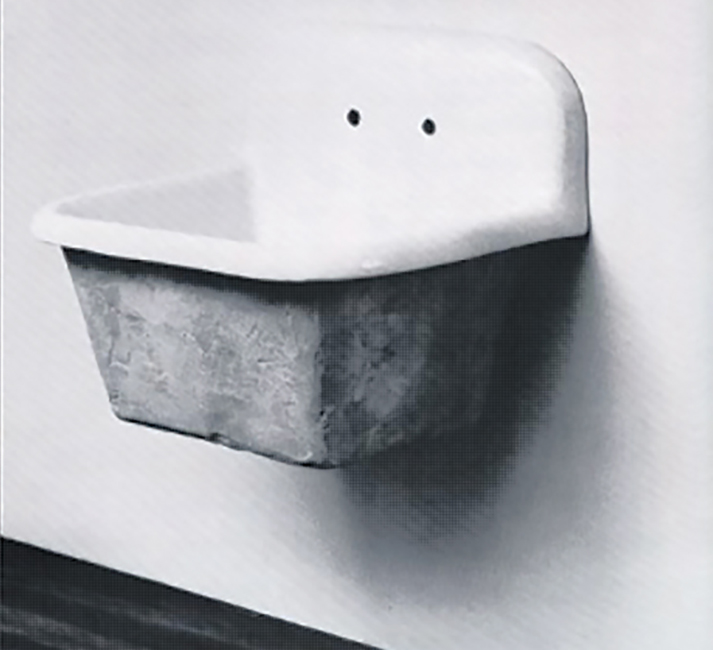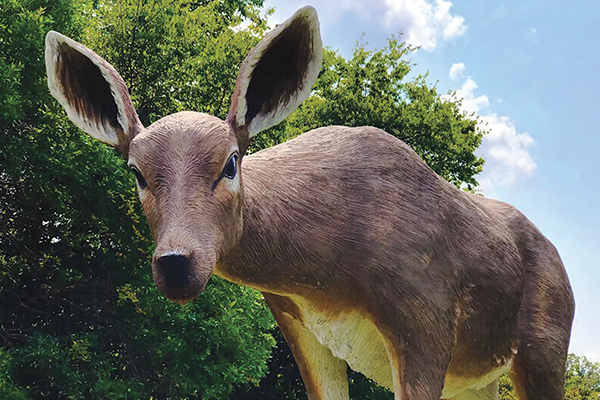Art, Ambition, and the Weight of Stars: Dining at Esmé in Chicago
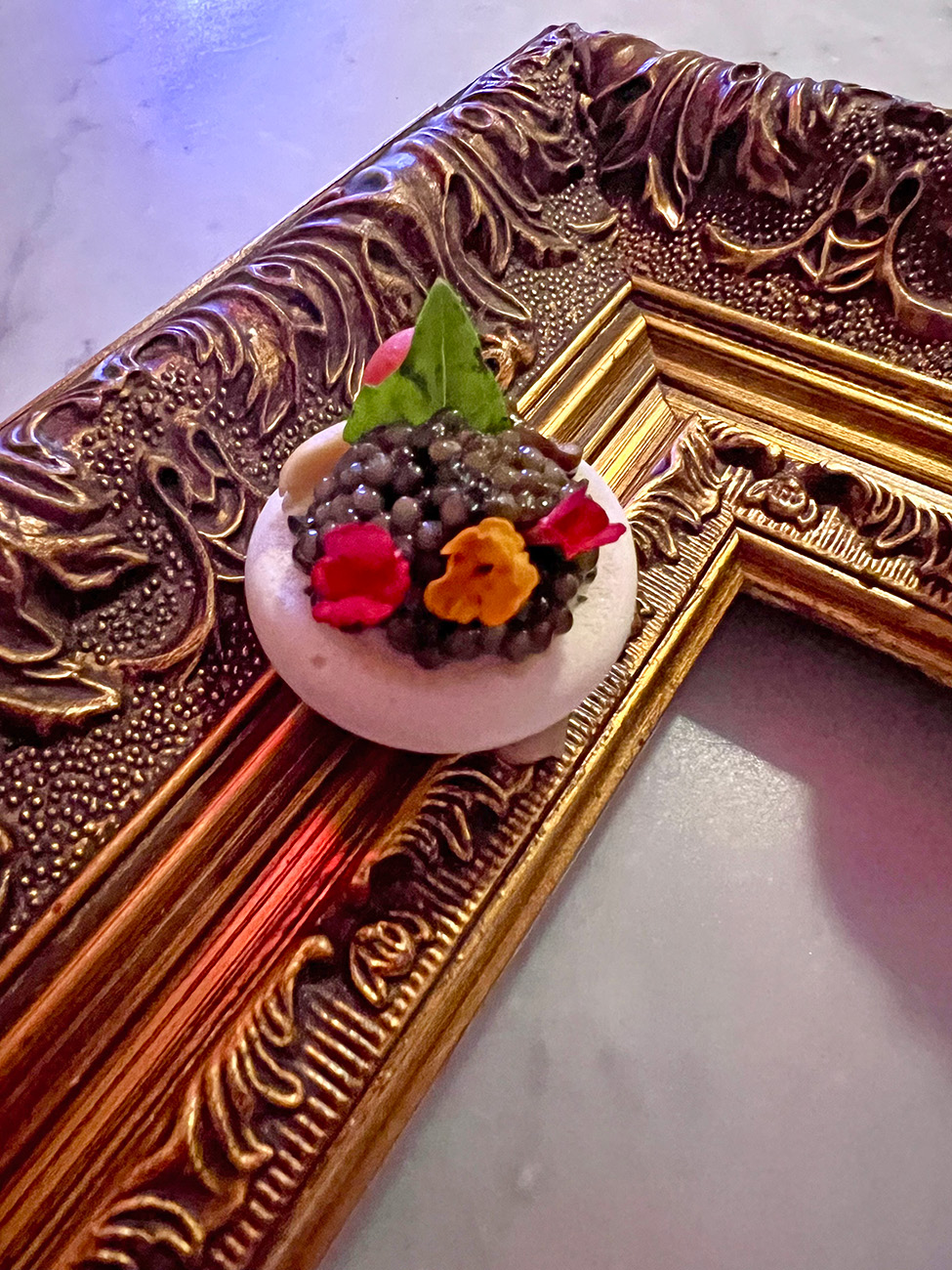
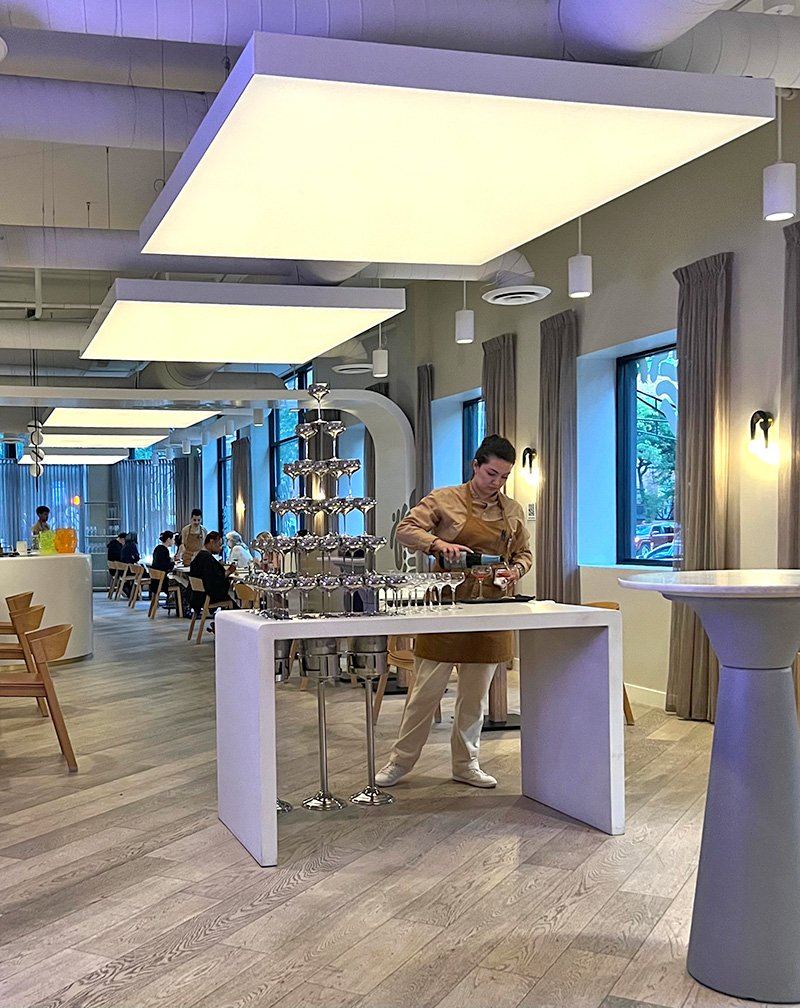
Esmé's light fixtures already resemble blank canvases. All photos by CGN.
By GINNY VAN ALYEA
On a warm Chicago evening earlier this fall, stepping into a Lincoln Park restaurant felt more like crossing the threshold of a gallery than a restaurant. Most of my days as publisher of CGN are spent in proximity to art, and I do eat at restaurants, but I can’t say I’ve had a meal or art experience quite like the one I had at Esmé.
That is the point. From its earliest days, Esmé has set out to merge food, art, and philanthropy in an ambitious experiment. Now, with an Apple TV+ docuseries running and Michelin inspectors circling once again, the restaurant finds itself back in the spotlight.
I had heard about Esmé since it was awarded a Michelin star in 2022, less than year after it opened in 2021. Esmé is the culinary artistic-collaboration of husband-and-wife duo Chef Jenner Tomaska and Katrina Bravo, who opened the restaurant as both a fine-dining destination and a mission-driven project. Their vision was that a restaurant could be more than an elevated place to eat — it could also be a civic space, an art gallery, and a philanthropic engine all at once.
Esmé’s tasting menus change with each artist-in-residence collaboration, transforming both the dishes and the dining room into a temporary exhibition. Previous artist collaborations have been with Emmy Star Brown, Raspy Rivera, and Meghan Borah, and others. Proceeds from these seasons often benefit local nonprofits, creating a direct tie between indulgence and community impact.
The current collaboration features Chicago-born, L.A. artist Lefty Out There (Franco Campanella), known for his looping, interlocking “polymorph” motifs. His work, which began in graffiti and street art, now spans textiles, sculpture, and digital installations — a rhythmic visual language that feels both infinite and playful.
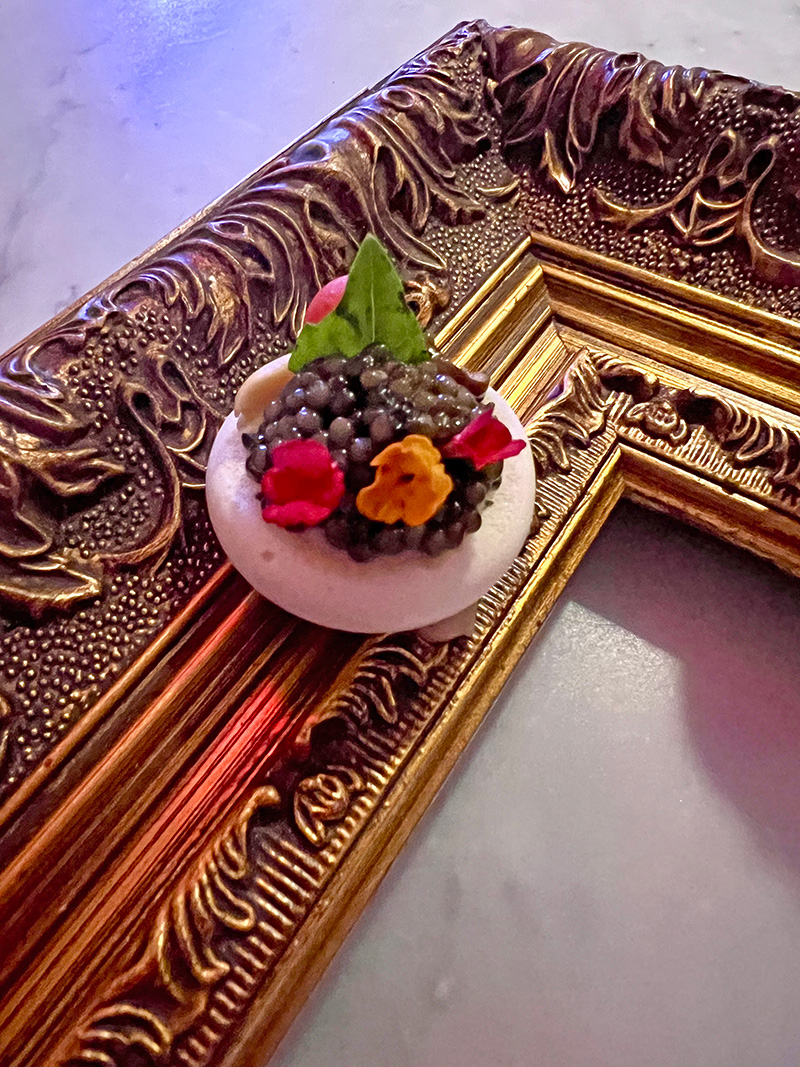
The surprise amuse: Meringue - Tomato, Peanut, and Osetra Caviar.
At Esmé, Lefty’s work is hung salon-style on the wall when you first enter the space. While I waited for my dinner date to arrive, I was greeted by Chris, who offered water, as well as a sparkling wine with fall-appropriate cherry incorporated – a bright, pink palate preparation to enjoy while I had a chance to look around the space, first at the art, including a projection piece, then at the professional staff moving quietly and efficiently among the tables and back and forth to the open kitchen. In the dining room large, white fixtures – flat panels suspended from the ceiling that resemble white canvases – act as blank spaces that reflect light back onto where the art really was, on the tables and plates.
Once my friend arrived we were presented with what we thought was a mutually favorite hors d’oeuvre: deviled eggs. In fact this was the first surprise of the night, as it was not an egg, but a tomato meringue with caviar, peanut and delicate edible flowers. There were two, placed atop a thick, gilded picture frame.
The presentation of this first bite made the art-links of Esme’s menu apparent, but once we were seated at our table the unique collaboration with Lefty Out There was unmistakable. The current tasting menu–which began in August and it set to continue at least into the new year–is inspired by Lefty’s hallmark polymorphic shapes.
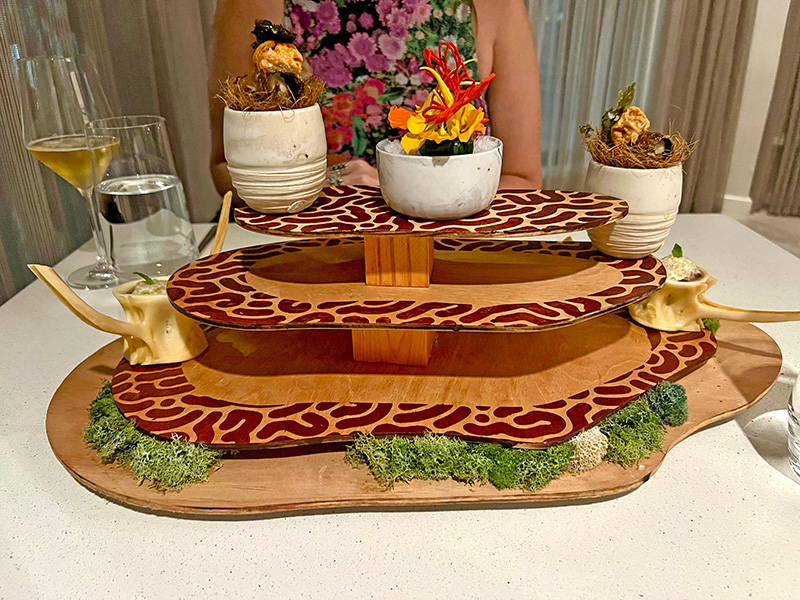
A custom designed tray built from wood and moss serves Tuna — peach jam, otoro, sake sabayon, and tuna bone marrow, Uni — nori, sunchoke purée, fried kelp, and kelp oil, and Foie — whipped foie with hoja santa, cherry, nasturtium, and a butterfly tuile — a reflection of the land above.
There is color, detail, intricacy in each dish, with many being served on custom made dishware and plates. A custom sculpture Hassun Tray built by Lefty from layered wood and moss draws on Lefty’s experience using LiDAR digital mapping and references contours that mirror map elevations and topography. As you eat each introductory bite you move through nature, from sea (tuna, also nori, kelp) onto land (whipped foie, cherry, nasturtium). The art presented in the tray’s design remains after each bite is gone.
A two-bite course of smoked grapes, latticed over king crab-filling, is topped with fennel and presented atop a 3-D printed copper-hued dome that resembled a brain, though not in an unappetizing way. The serving piece looked like it would be heavy, made of metal, but it’s very light. The dish was the same, it looked heavy but was in fact delicate.
Colors. Detail. Intricacy. Lefty’s art lends itself to repetition – certain shapes and curves are like disciplined doodles. You can’t quite always identify an exact pattern but you can pick out the shapes. The artist has broad experience in multiple mediums, from 3D printing and murals to fiber and painting. At Esme you see Lefty’s presence everywhere.
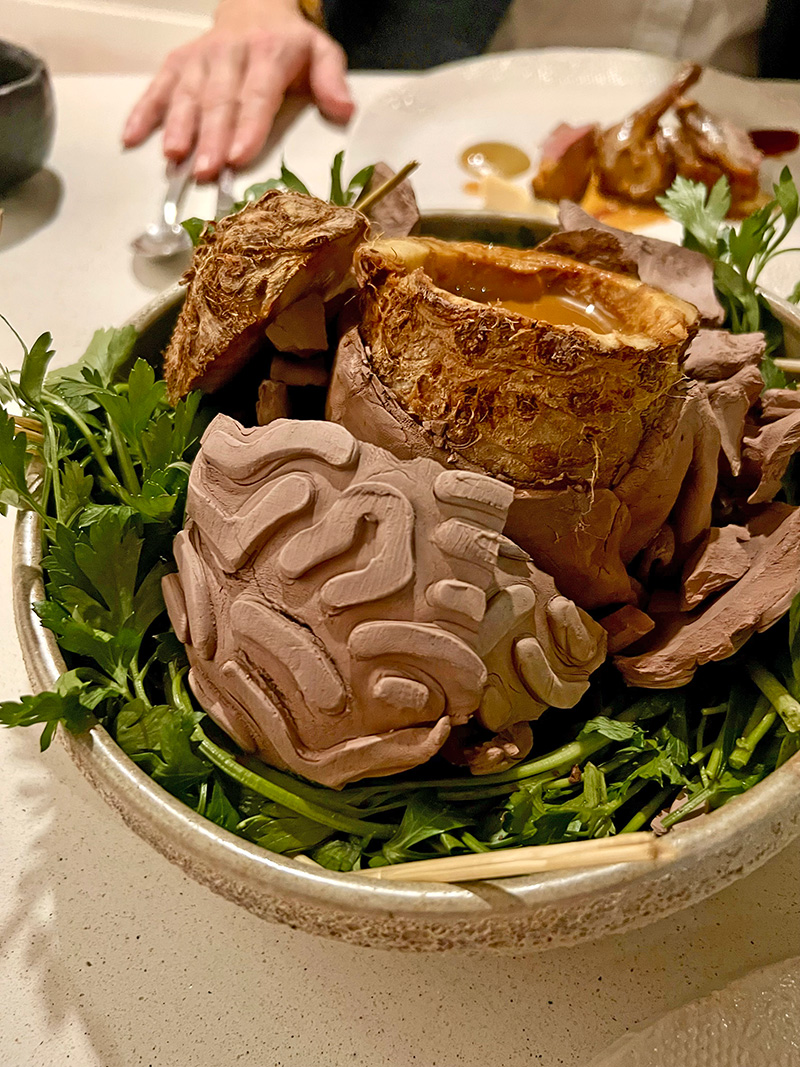
Lefty's designs in clay. A dish of squab, foie, plum, tamarind, celery root and nihari
For a dish of squab with plum, the vibrant tamarind sauce that accompanied it was baked in celery root inside of a clay vessel featuring Lefty’s squiggle designs. Our server used a special hammer to break open the clay and reveal the sauce. Next we had wagyu beef, beet mole and charred lettuce, accompanied by an unusual, Italian-style wine from Mexico.
Other dishes we had didn’t directly draw from Lefty’s art but still incorporated the creativity of local artists. One of the restaurant’s signature dishes of caviar and ice cream with white chocolate and some sort of savory pepper paste was served in a custom designed, ostrich-sized ceramic egg, chilled to best present and preserve the coolness of the ice cream.

Shareable ice cream and caviar mid-meal. Mother of pearl — peanut miso, celery hot sauce, sweet potato ice cream, white chocolate, osetra caviar.
Desert was part art heist, part treat. All surprise – cake concealed beneath printed rice paper made to resemble a painting on canvas, framed in gold. To get to the sweet cake, I had to destroy the canvas.
Each effect is immersive and unique: dishes appear not just plated, but staged, like performers in an abstract set. Signature forms ripple across everything, from custom placemats (24 in total, hand-sewn with 88,000 stitches), to laser-cut tray designs, and even the plating itself.
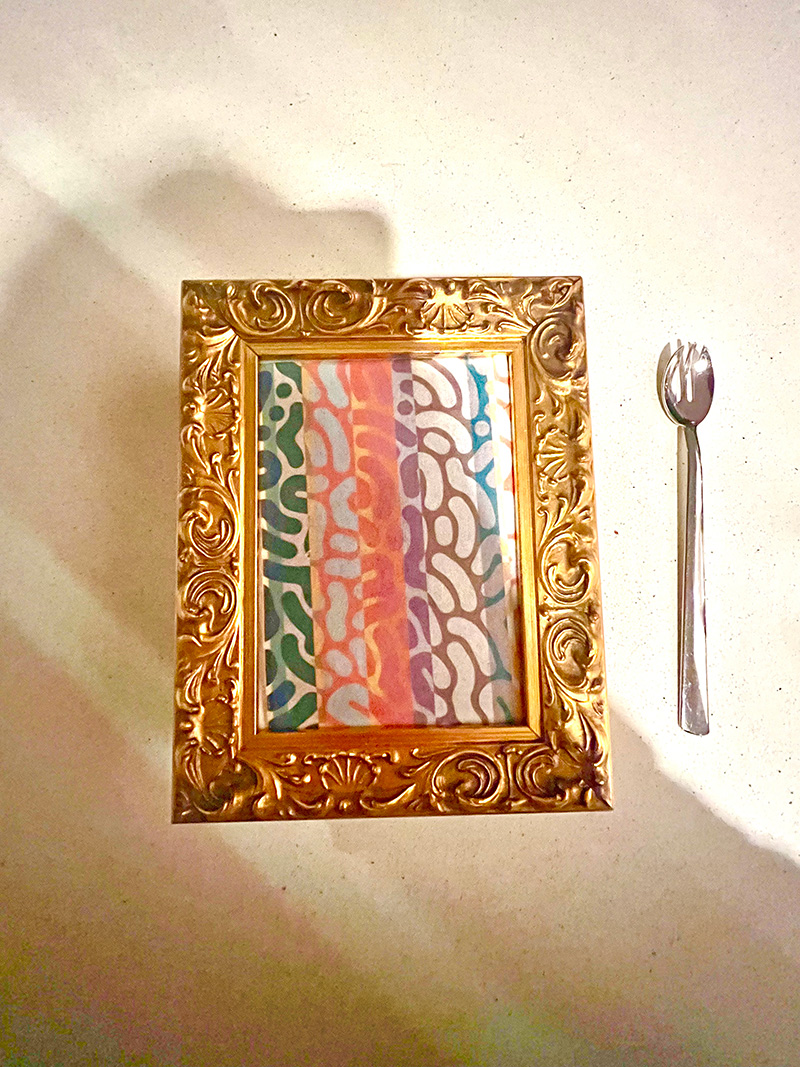
Dessert is behind the rice paper canvas: blackberry vanilla opera cake, oat crumble, anise hyssop ice cream
*
To expand on where Lefty Out There’s art fits in a dining space, Allan Weinberger, director of VSG Contemporary, which represents Lefty, describes how this project is not unlike other collaborations and is well suited for an art experience.
“Franco Campanella, Lefty’s formal name, loves integrating his art into culturally adjacent moments,” says Weinberger. “He’s collaborated extensively with John Summit on music projection mapping, Miami nightclub E11even, Formula 1, the Chicago Half Marathon and various fashion brands. His visual language adapts well to different environments. For the diner, the experience is unique and engaging, you get to learn about and be inspired by an artist while enjoying a meal. It’s immersive, playful, and unlike a traditional art encounter.”
For Esmé’s latest residency Weinberger describes the partnership as a natural extension of the artist’s trajectory.
“Since opening, Esmé has developed a Michelin-starred dining experience that deeply integrates art into its courses,” he says. “The restaurant transforms several times a year with new artist collaborations. Lefty Out There elevated this concept further, introducing custom design elements across the space, from windows and placemats to dishes, while curating the gallery with a selection of new works alongside pieces returning from his 2023 London exhibition, many of which had never been shown in the United States.”
When I asked Weinberger how he would describe the partnership of having an artist exhibit in a dining setting, he explained, “As an art dealer, I’m not usually drawn to showing work outside spaces made for art. If people aren’t coming in conditioned to see art, the work rarely lands, and it definitely doesn’t sell. We looked at this opportunity carefully and felt that, with the right planning, it could really work. We just wanted to ensure it was presented as an art show.”
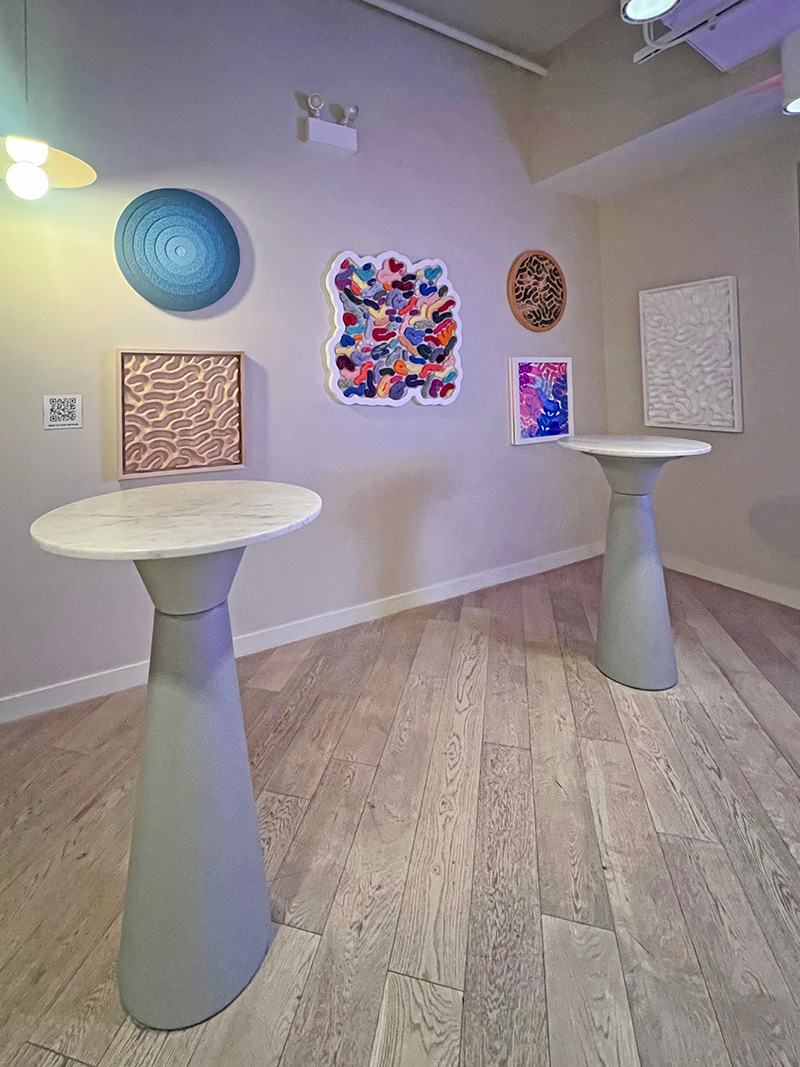
Lefty Out There works hang salon-style
That was easy, he says, because of the creative leaders behind Esme. “Jenner Tomaska is more than a chef, he’s a brilliant culinary artist and his collaboration with Lefty Out There felt like a genuine creative match. They both care deeply about their craft and it’s more than a business. At one point, while producing custom plates for a dish, they simultaneously decided the quality wasn’t good enough for service and the plates were pulled. This partnership wouldn’t work with just any restaurant; it had to be an exceptional one, like Esmé. Our goal was to make the presentation feel intentional and artistic, not just like restaurant décor.”
Exhibiting art outside of a formal gallery space always takes creativity, but hopefully it results in many rewards because it invites and allows a different kind of access and has the potential to engage a new audience. I asked Weinberger what the challenges have been as well as unexpected outcomes of this kind of collaboration.
“The biggest challenge was managing the logistics—shipping, installation, and planning for a project that’s inherently speculative. If the art doesn’t sell, it can be a tough financial situation. Fortunately, with the support of Frame Chicago, who helped curate the partnership, the opening week went very well in terms of sales, setting a strong tone for the rest of the collaboration. The collector response to this show has exceeded expectations and we’re thrilled. For years, Alisha, Shafiq, and Firoz have witnessed the transformation of the contemporary art scene, evolving Frame Chicago from a casual framing shop into a cultural hub. They have a pulse on what’s happening in the art world, and both Lefty and I deeply admire the artistic excellence they represent.”
*

Cheese coral – aerated Epoisses and Gruyere, taiyaki, and honeycomb
The Esme dining room feels alive with visual rhythm. One late-meal course, dubbed “Cheese Coral”, arrives as a sculptural reef of airy cheese, honeycomb and red Taiyaki pastry shaped like a coy fish, simultaneously fragile and abundant. Another paired turbot with melon and corn, a geometric interplay of textures and tones that echoes Lefty’s looping patterns. These are not just bites; they’re compositions — edible artistic choices meant to be admired and then consumed.
As a diner the specific presence of art forces you to sense details — the cut of a vegetable, the texture of a sauce, the angle of a garnish. Esmé transforms eating into something closer to observing. I thought about how each dish would be if it weren’t part of a chef + artist partnership and wondered why there aren’t more like it, since the creative synergy felt so natural. I also wondered, since this partnership with Lefty is so complete - on the walls, on the plates, in the serving pieces – what would other collaborations be like? Would they all be as successful?
*
This fall, Esmé’s story has been on the plate as well as the screen. On October 10th Apple TV+ debuted Knife Edge: Chasing Michelin Stars, an eight-part docuseries that follows chefs worldwide as they pursue, retain, or risk losing their Michelin standing. Esmé is one of the featured restaurants.
The series aims to reveal the unseen side of fine dining: the relentless precision, the anxiety of inspection, the personal toll of an elusive rating system. For Tomaska and Bravo, the cameras arrive at a high-stakes moment. Michelin will announce its 2025 ratings next week on November 18th, when Esmé will learn whether it keeps (or loses) its single star — or potentially ascends to the coveted two-star echelon. With the recent news that a fellow Chicago restaurant, Alinea, has lost one of its three stars and now will boast two, the pressure is on for Esmé to move up and maintain the city’s overall star count.
While diners at Esmé experience a serene, gallery-like dining room each week, viewers worldwide are tuning in to glimpse the sweat, tension, and vulnerability behind its closed doors.
*
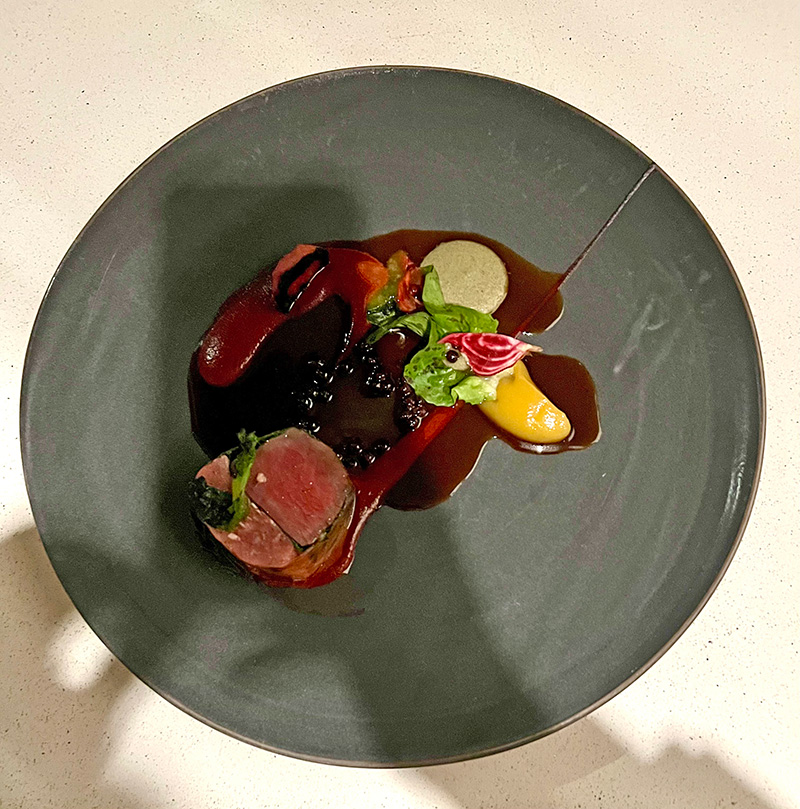
Wagyu - Red beet mole, romaine sauce, golden beet puree, pickled mulberries, confit beets
What’s striking about Esmé is how seamlessly it toggles between the intimacy of fine dining and the spectacle needed to gain and keep global attention. On one hand, a dish like the turbot with melon feels like a deeply personal of the chef— the kind of course that asks for quiet. On the other, the entire concept of collaborating with an artist is inherently performative, begging for documentation and a wider audience.
The docuseries heightens this duality. How does a restaurant designed to be immersive for those in the room translate when broadcast to millions of viewers? Will the art-dining fusion appear as sincere as it feels in the moment, or risk seeming contrived under the harsh gaze of editing?
This is the tension at Esmé’s heart: the space between experience and performance, authenticity and ambition.
*
Esmé’s significance goes beyond its four walls. In spotlighting Chicago artists, and funneling resources into local causes, the restaurant positions itself as a civic player in the city’s cultural ecosystem. In Lefty Out There, Esmé found a collaborator whose Chicago roots mirror its own, creating a uniquely local resonance in a global fine-dining landscape.
As Weinberger suggests, by placing Lefty’s work on dining tables instead of gallery walls, Esmé underscores Chicago’s ability to redefine the boundaries of cultural experience.
Art was on the walls, certainly on the table, and in each dish. Maybe best of all, I had an inventive, magical setting for a long overdue catchup with a dear friend on a lovely fall evening in one of the world’s most creative cities.
View past menus and artistic collaborations at esmechicago.com and @Esme_Chicago
Follow Lefty Out There @LeftyOutThere
#

